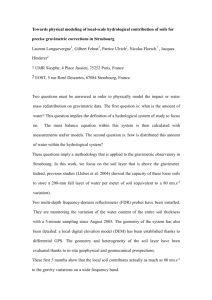Doc - WMO
advertisement
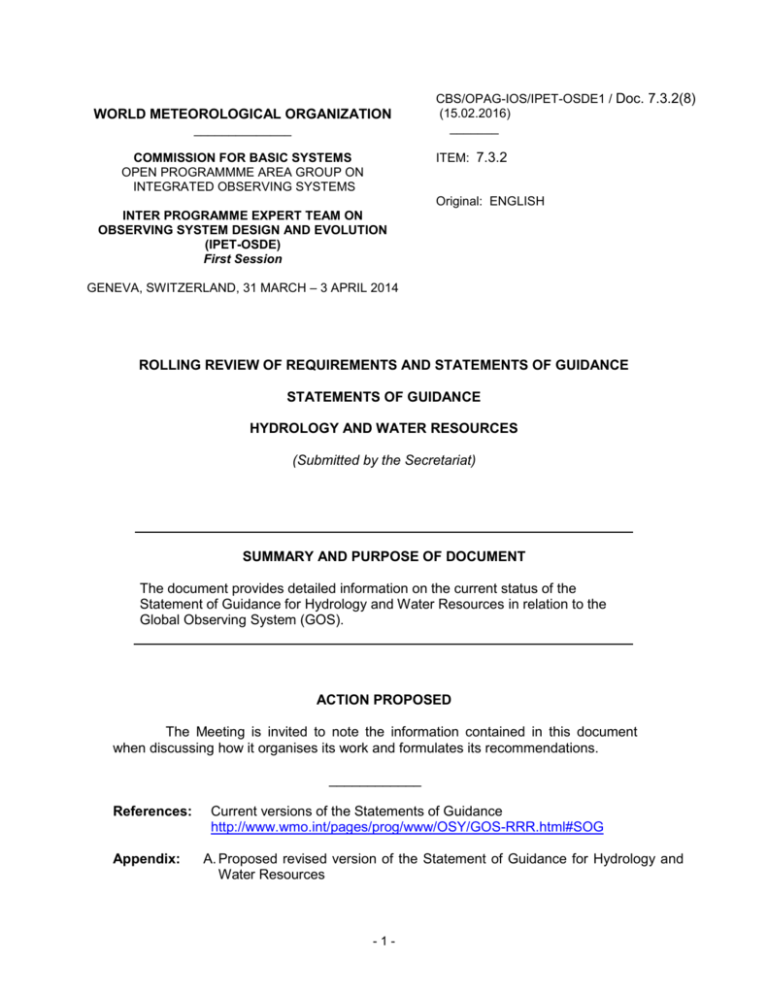
WORLD METEOROLOGICAL ORGANIZATION ______________ CBS/OPAG-IOS/IPET-OSDE1 / Doc. 7.3.2(8) (15.02.2016) _______ ITEM: 7.3.2 COMMISSION FOR BASIC SYSTEMS OPEN PROGRAMMME AREA GROUP ON INTEGRATED OBSERVING SYSTEMS Original: ENGLISH INTER PROGRAMME EXPERT TEAM ON OBSERVING SYSTEM DESIGN AND EVOLUTION (IPET-OSDE) First Session GENEVA, SWITZERLAND, 31 MARCH – 3 APRIL 2014 ROLLING REVIEW OF REQUIREMENTS AND STATEMENTS OF GUIDANCE STATEMENTS OF GUIDANCE HYDROLOGY AND WATER RESOURCES (Submitted by the Secretariat) SUMMARY AND PURPOSE OF DOCUMENT The document provides detailed information on the current status of the Statement of Guidance for Hydrology and Water Resources in relation to the Global Observing System (GOS). ACTION PROPOSED The Meeting is invited to note the information contained in this document when discussing how it organises its work and formulates its recommendations. ____________ References: Appendix: Current versions of the Statements of Guidance http://www.wmo.int/pages/prog/www/OSY/GOS-RRR.html#SOG A. Proposed revised version of the Statement of Guidance for Hydrology and Water Resources -1- CBS/OPAG-IOS/IPET-OSDE1/Doc. 7.3.2(8) DISCUSSION 1. The Statement of Guidance for Hydrology and Water Resources has been updated as of February 2014, to reflect the requirements of the WMO Hydrology and Water Resources Programme. A copy of the revised guidance is at Appendix A. 2 It is important to recognize that hydrological in situ observations are very different to climate and weather in situ observations in that climate and weather data are representative of a single point. That is, this is the temperature at this place at this point in time, or this is the precipitation at this place at this point in time. For both surfacewater (discharge) and groundwater (pumping rates), the measurement while taken at a point, is representative of an entire catchment area or an aquifer and is this directly related to a measurement taken upstream or downstream or at other points of the aquifer. Therefore, a gridded or areal map of discharge is a complex and difficult concept to fully comprehend, especially across catchment boundaries. 3 Satellite remote sensing, though increasingly used for the monitoring of precipitation, is generally of more limited utility in hydrology. Although altimeters on spacecraft have been demonstrated to measure the water surface elevation of major water bodies and very large rivers, the sensing of stream discharge and groundwater levels remains problematic at this time. Importantly, hydrological applications of remote sensing remain largely an expensive research activity, of little or no applicability to most National Hydrological Services around the world. _______________ -2- CBS/OPAG-IOS/IPET-OSDE1/Doc. 7.3.2(8) APPENDIX A PROPOSED REVISED VERSION OF THE STATEMENT OF GUIDANCE FOR HYDROLOGY AND WATER RESOURCES (Point of contact: HWRP, WMO) (updated February 2014 by HWRP, WMO, and last approved by ET-EGOS-4, July 2008) The collection of hydrological data is crucial to evaluating the quantity and quality of the world’s water resources, as well as to improving our understanding of the global hydrological cycle. Hydrological data contribute to sustainable water resources management as well as to weather and climate-related scientific and application issues. The availability of information on hydrological extremes contributes significantly to the reduction of the impacts of disasters, both through infrastructure design and through nonstructural approaches to floodplain and drought management. For most currently available observations, the adequacy of observational networks varies dramatically from region to region. Observations for some of the variables described below are inadequate in terms of both spatial and temporal coverage. As a methodological approach it has become evident, that observations of hydrological variables on global and regional scales in a continuous and consistent manner will require integrated observation systems making use of both terrestrial as well as satellite observations. The use of data assimilation techniques using the combination of data from these integrated networks and multi-platform observations will give rise to improved products and services, at least with respect to spatial coverage. However, the importance of in-situ observations of hydrological variables cannot be overstated. 3.10.1 Hydrology and Water Resources Programme Requirements The Terrestrial Observation Panel on Climate (TOPC) identified 11 hydrometeorological variables with a high observation priority (GCOS, 1997). An expert meeting on the Establishment of a Global Terrestrial Network – Hydrology (GTN-H) confirmed these 11 variables (GCOS, 2000) recognizing that several of these variables have both an in-situ as well as a satellite observation component. The variables of direct relevance to the Hydrology and Water Resources Programme and their current state of observation are briefly discussed in the paragraphs below. However, it needs to be noted, that observational requirements over the oceans are not reflected in the Statements of Guidance (SOGs) related to the Hydrology and Water Resources Programme. In this regard, a critical field where global observations are required is the early detection of storm surges, in particular in combination with riverine floods in low-lying coastal zones. Storm surge detection is possible using satellite-based altimetry. At present, global observations are not undertaken on a routine basis. Variable Surface water discharge Surface water storage fluxes Groundwater fluxes Precipitation (liquid/solid) GCOS Variable Yes Yes Yes Yes -3- HWRP Variable Yes also in WHOS Storage as opposed to fluxes Storage as opposed to fluxes Yes CBS/OPAG-IOS/IPET-OSDE1/Doc. 7.3.2(8) Evaporation Vapor pressure/Relative humidity Soil moisture/Soil wetness Snow cover, depth, and water equivalent and glaciers Land surface temperature Vegetation type and NDVI Water Use Yes Yes Evaporation and Evapotranspiration See Evapotranspiration Yes Yes Yes Yes Yes Yes Yes See Evapotranspiration Yes Yes Temporal requirements for data used in hydrology and water resources are classified in two ways: (i) the first is non- or slowly-time dependent data such as topography and land use; and, (ii) the second is time dependent data needed to initialize and update forecast models such as rainfall rates or soil moisture. Satellite data is the only means for providing high spatial and temporal resolution data in some key regions (e.g., forested areas). In-situ data provide acceptable coverage in limited regions and are also used for calibration and validation of hydrological models. To meet hydrological forecasting needs, the data must be available within 1/2 to 6 hours, depending upon the size of the basin and forecasting requirements. Products useful to hydrology are listed below with a description of how well they meet the hydrological model needs and whether or not they are time-sensitive. For example, hydrologic variables such as snow cover, snow water equivalent and soil moisture are dynamic variables that must be updated fairly frequently. Variables for which data delivery is time sensitive (less than 6 hours) are indicated. 3.10.2 Hydrology and Water Resources Requirements Surface Water Discharge Discharge is typically calculated at a particular location in a river, but represents the water running off from the entire catchment into the river above that location. It is derived from a measured water level (stage) converted to discharge by means of a rating curve developed for the particular channel cross-section at which the water level is measured, or by more accurate-theoretical methods where possible (e.g. rated weirs. Rating curves can be theoretically derived, but are generally empirically developed from a series of discharge measurements, and then extended graphically to flows at stage heights for which the discharge has not been measured. Flow in a channel can be influenced by factors such as changes in land use, withdrawal for water use, or contributions from artificial water storage reservoirs; thus, weather is not the only variable affecting discharge. The quality of discharge measurements is also impacted by unstable controls at the measuring point and in some cases tidal influences. On a global scale, terrestrial hydrological observations are not available for all catchments and are generally unavailable or of poor quality in remote and mountain areas. Access to hydrological data is often impeded by a number of factors including fragmentation of data holdings at the national level and access restrictions. Two new approaches to global monitoring are the planned implementation of the Hydrological Applications and Runoff Network (HARON) in cooperation with the WMO, GCOS, GRDC and facilitated by -4- CBS/OPAG-IOS/IPET-OSDE1/Doc. 7.3.2(8) GEOSS and the WMO Commission for Hydrology proposal for a WMO Hydrological Observing System (WHOS). Likewise, the WMO’s WHYCOS Programme contributes to the improvement of surface hydrological networks, but usually based on a specific need for hydrological information, such as flood forecasting and warning or water resources management. On a local basis, satellite derived water-level observations based on altimeters are available for some large rivers and can now be utilized for major basins (wide rivers) and lakes in a quasi-operational mode. The quality of such observations is yet to be fully determined and in-situ observations for calibration are essential. Several satellite-based methods are available on demand to map the extent of flooding in floodplains or large riverine systems as well as the duration of flooding, including visual, IR and radar sensors. However, in general, hydrological observations from spacecraft are not available for any given location on a daily basis owing to the geometry of spacecraft orbits. In most instances, it may only be possible to obtain data once every two to three weeks at a specific location which is a serious constraint. Surface water storage This variable is directly related to the volume of freshwater stored in lakes, reservoirs and wetlands. Again storage volume is usually derived by measuring the height of the water in the lake or reservoir and then converting this to a volume using a height versus storage volume curve derived from elevation data or information on the topography beneath the water body. There is also the issue of water storage in river channels, flood plains and large estuaries which is more of a challenge to measure continuously. While terrestrial observations are being made for lakes and reservoirs (levels of lakes and reservoirs, volumetric observations), space-based observations such as those derived from altimetric observations are also becoming more readily available. However, these are water level elevation values only and, without the relevant storage height-volume curves, do not provide information on the actual amount of water within the lake or reservoir. Generally, observations are not yet available for wetlands, large floodplains and estuaries. This may change with improved digital elevation data. The availability of surface water storage fluxes for the major lakes and reservoirs would contribute to a more accurate modelling of lateral fluxes in climate circulation models. The fluxes would be best derived from the storage volume data rather than changes in height only. Presently, the ability of the ICES/GLAS instrument to provide accurate measurements of lake levels is being tested. Again, in-situ records are invaluable. However, many observational uncertainties still exist with regard to flow retention in dams, reservoirs, lakes and wetlands; the evaporative loss of water from storage surfaces; and seepage to groundwater stores. Groundwater storage Groundwater storage is also a difficult variable to measure as usually it is the height of the groundwater level that is recorded and the volume/water availability derived from pump testing and geographical analyses. Groundwater fluxes have a major influence on the dynamics of the global hydrological cycle as they represent water coming back into the surface water realm through pumping or springs and also water flowing from the surface water to groundwater via recharge of aquifers. Because groundwater tends to respond more slowly to short-term climatic variations than surface water resources, this variable is often not considered to be of first-order importance from a climate perspective. However, in fact, its long term nature does lend it to be of importance in longer time scale analyses. Terrestrial observations are being made but -5- CBS/OPAG-IOS/IPET-OSDE1/Doc. 7.3.2(8) overall global access to groundwater data (rates of recharge and abstraction in particular) is highly limited. IGRAC has compiled global level information on groundwater resources. Gravimetric observation techniques (such as from GRACE) for very large groundwater bodies are available but yet to be fully proven in operational circumstances. The use of GOCE data is being explored. Precipitation (liquid/solid) Various meteorological variables including precipitation depth and type are routinely observed on an hourly to daily basis at synoptic weather stations. Global coverage from in-situ observations exhibit large regional differences. Exchange of data is achieved in real-time and near real-time mode and subsets of the precipitation measurements made are accessible through global networks and data centres. Increasingly, spatial and temporal coverage of rainfall observations is improving using ground radar techniques. Satellite observations from on-board radars as well as microwave imagers and sounders are also of value and enable precipitation information to be derived on a global scale. Merged data products using direct terrestrial observations and satellite observations are routinely available at the global scale. However, quantitative precipitation observations from satellite measurements at present do not meet accuracy requirements; but when combined with terrestrial observations they provide precipitation estimates with an improving resolution. Information from TRMM satellites and the emerging precipitation network through the virtual constellation network of CEOS provide improved precipitation information that can be used flood forecasting. Major progress is expected from the Global Precipitation Mission (GPM). There is a focus on improving satellite and radar based rainfall information in real-time for use in flash flood forecasting. This is operationally achieved by making use of hydrological S-band Doppler radars and improved satellite-based observations. As quantitative precipitation forecasting using S-Band Hydrological Radars increase in popularity especially for flash flood forecasting in many countries, improved guidance for calibration and intercomparison of accuracies is required. With regard to satellite-based quantitative precipitation estimation, a mechanism is required to develop front-end products and mainstream precipitation products for operational day-to-day use in National Hydrological Services on a long-term basis. Evaporation and Evapotranspiration Evaporation is a critical value in the water balance equation as well as in regional water budget estimations. Evaporation is the process of water changing from a liquid into a gas or vapor. However, direct observations are sparse and most evaporation values are in fact derived estimates. Evaporation in the context of the SOG’s refers to "direct" measurements of actual evaporation. Because of the observing methods, even direct measurements are estimates. Terrestrial measurements on a global scale are declining in terms of spatial coverage at a time when traditional in-situ observations like evaporation pans and lysimeters are largely discontinued. Replacing traditional observation methods by using flux towers, evaporation estimates are made using eddy correlation and Bowen Ratio techniques. The number of these towers is very limited and data are not readily available on a global scale. Isotopic measurements can provide an effective method to derive evaporation as ratio of change of water stable isotopes between vapor and the residual liquid. -6- CBS/OPAG-IOS/IPET-OSDE1/Doc. 7.3.2(8) Evapotranspiration is important to the hydrologic cycle because it represents a considerable amount of moisture lost from a watershed. As precipitation falls and soaks into the soil, a plant absorbs it and then transpires it through its leaves, stem, flowers, and/or roots. When this is combined with the evaporation of moisture that was not directly absorbed by the soil, a significant amount of water vapor is returned to the atmosphere. As part of the hydrologic cycle, there are several factors affecting a plant's rate of transpiration and therefore evapotranspiration. These are: Air temperature; Relative humidity (the amount of water vapor in the air); The movement of wind and air across an area; The moisture available in a plant's soil; and The type of plant involved in the transpiration process. Soil moisture/Soil wetness The observation of soil moisture or soil wetness (as a proxy for soil moisture) is important for hydrological forecasting in large river basins and likewise for modeling of the land surface module in coupled land-atmosphere models. A number of networks for soil moisture measurements exist in different parts of the globe. The identification of a global in-situ network on soil moisture is in an advanced planning stage. This will involve network enhancement by expansion and standardization, dedicated soil moisture missions (support for SMOS, ESA’s soil moisture ocean salinity satellite mission), and improved coordination of soil moisture data network planning, observing standards, and data exchange. The use of advanced scatterometers allows derivation of soil wetness of the first few centimetres that however is only partially useful for hydrological studies and forecasting and need to be augmented by infiltration models, for example. On terrain, soil wetness can also be observed by passive microwave emission radiometry. On a global scale, with a spatial resolution of about 30-50 km, L-Band radar may provide spatial coverage. On a regional basis, a soil moisture index for Europe and Africa is derived from meteorological satellite data; this work is done within the framework of the EUMETSAT Satellite Application Facility for Land Surface Analysis (Land-SAF). Most of the active and passive microwave instruments provide some soil moisture information for regions of limited vegetation cover. However, under many conditions remote-sensing data are inadequate, and information regarding moisture depth remains elusive. Unfortunately, none of the instruments provide a satisfactory combination of spatial resolution and repeat cycle time (2 to 3 days). The AMSR data comes close to providing soil moisture or land wetness information that may be marginally useful for meso-scale models but the timeliness of these data remains challenging. Snow cover, depth, and water equivalent and glaciers Seasonal snow cover is an important storage of water and largely regulates streamflow regimes and water resources management practices in many major river basins. Due to its high albedo, snow cover plays an important role in radiance and the land-atmosphere energy budget. Water stored in snow and ice, especially in mountain regions of the earth are critical for water resources management for a large percentage -7- CBS/OPAG-IOS/IPET-OSDE1/Doc. 7.3.2(8) of the global population. Conventional terrestrial observation methods include snowpillow networks and regularly worked snow depth measurement courses as well as networks of snow gauges. Derived from measured snow densities, snow water equivalent is calculated as an important hydrologic derived variable. On the northern hemisphere, snow observations are generally adequate but a real representativeness of snow cover thickness can often not be assessed with a high reliability. Satellite-based systems include AVHRR sensors. On a regional basis, passive microwave sensors such as SSM / I can be used to map extent and depth of moderate-thick snow covers. The overall important snow-water equivalent of snow packs should be derived on the basis of improved algorithms from microwave brightness temperature. Current and planned polar orbiting satellites should provide acceptable data on snow cover. AVHRR provides adequate snow cover information; the addition of the 1.6 micron channel has been useful in discriminating snow from clouds. Snow maps are being made available from the multi-channel (36 channels in the visible and near infrared wavelengths) MODIS instrument within 48 hours after data collection. The passive microwave instruments (i.e., SSM / I, AMSR) have all weather and day / night monitoring capability and are able to estimate the thickness of dry snow up to about 80 cm deep. These snow cover measurements are acceptable for mesoscale modelling and snowmelt runoff forecasting. The passive microwave AMSR and SSM /I provide useful estimates of snow water equivalents where there are validated regional algorithms. Current acceptable algorithms are based on the brightness temperature difference between the 19 and 37 GHz channels. There is no general algorithm that can be applied to all regions. Regional modifications are necessary to account for snow grain size (climate related), vegetation (especially forested areas) and elevation. The measurements are acceptable for water balance studies and snowmelt runoff forecasting in large basins. Vegetation type and NDVI AVHRR and MODIS are providing acceptable and in some cases, good NDVI and vegetation type data. However, in some cases, the NDVI and vegetation type products may not be interchangeable because of slightly different spectral bands. The cycle times in most cases are acceptable for NDVI and adequate for vegetation type because they do not change very rapidly. METEOSAT Second Generation offers the opportunity to investigate diurnal changes in NDVI. Water Use In the management of water resources as well as the assessment of the potential natural flow of water in rivers information on water use is of great importance. However, at present only limited information is available on this variable that is also highly heterogeneous in quality and availability (administrative, spatial and temporal). While sectoral information (mostly estimates) are available on a national and local government basis, global consolidated information on water use both consumptive and non-consumptive is not available and most existing information is extrapolated or derived from relatively few accessible data sources. The most advanced data base on water use, focusing on irrigation is AQUASTAT maintained by FAO. In this regard, appropriate national organizations -8- CBS/OPAG-IOS/IPET-OSDE1/Doc. 7.3.2(8) should be encouraged to develop a reporting model of spatially resolved sectoral water use. The USGS scheme (reporting by both political and hydrologic spatial units, for various economic / industrial sectors, on a five-year time step) could be used as an appropriate model format. Furthermore, countries should make the information on water use internationally available. 3.10.3 Examples of Hydrology Products Generated from Selected Variables Table 3.10.1 below provides examples of products that can be developed on the basis of the selected variables as described above and the spatial and temporal resolution that could be achieved if the products were supplied in an operational mode. Some of these products are expected to be generated in activities related to the Global Terrestrial Network – Hydrology (GTN-H). Table 3.10.2 below provides a summary overview of the importance and usefulness of individual hydrological variables in relation to five thematic areas that are also served by information resulting from the operation of Global Observing Systems. Table 3.10.1 Examples for variable-derived products for hydrology, water resources, weather and climate applications Product name: Content: Discharge Gridded runoff fields Discharge Use (examples only): Spatial resolution: Temporal resolution: Timelines: Water balance computation 1o x 1o Monthly DT (delayed time) Point data Weather and flow forecasting; model validation N/A Hourly to Daily NRT (near-real time) Discharge Point data Global water cycle analysis By station (riverbasin) Daily/ Monthly DT Soil moisture Gridded (preferably) Weather and flow forecasting; assimilation in models TBD Daily to monthly NRT Precipitation Solid and liquid separately; point data Regional water cycle analysis; Hydrological forecasting 1dx1d globally; 0.5o x 0.5o regionally; point data Daily and monthly DT Precipitation, Point data Real-time Point Hourly to RT -9- CBS/OPAG-IOS/IPET-OSDE1/Doc. 7.3.2(8) evapotranspiration data for assimilation in models, water budgets Daily Snow water equivalent Gridded Various TBD TBD DT Ground water fluxes Aquifer withdrawal / recharge rates Various By aquifer TBD DT Water use Differentiated consumptive/nonconsumptive use Various Point or polygon Monthly, annual DT Water use Gridded consumptive / non-consumptive use Various 0.5o x 0.5o Monthly DT Surface storage Flux Volume changes in lakes and reservoirs Water cycle analysis Polygon Monthly or seasonal DT Table 3.10.2: Summary table of applications vs. hydrological variables Variable: Hydrologic, climate and weather forecasting: Climate variability, trend: Diagnosis, mitigation, adaptation: Sustainable development: Improved understanding of water cycle: Surface water – discharge e (v) E e e e Surface water storage fluxes e (v) d e e Ground water fluxes d E d e e Water use - - d e e Precipitation e (i,v) E - e e Evaporation D - - d e Vapor pressure/ relative humidity E - - - d E - 10 - CBS/OPAG-IOS/IPET-OSDE1/Doc. 7.3.2(8) Soil moisture e (v) - - d e (v) Snow water equivalent e (i) E - e e e= essential; d= desirable; v= validation; i= input 3.10.4 Summary of Hydrology SOG The following key points summarize the SOG for hydrology applications: With respect to the mission of the Commission for Hydrology, the most commonly collected and used hydrological data are river stage and discharge. By their nature, such data are complex and can be difficult to measure accurately. In general, collecting such data is expensive and, therefore, difficult to sustain over long time periods. Importantly, however, essential resource and safety activities like river forecasting, reservoir operations, flood frequency estimation, irrigation scheduling, water supply assessment, etc., critically depend upon accurate and timely (hourly to daily) stage and discharge measurements. Not surprisingly, therefore, within the domain of operational hydrology and the mission of most National Hydrological Services, remote sensing is not viewed as a viable alternative to in-situ data collection. The quantities capable of being sensed by spacecraft, and the frequency of repeat observations are not optimal for most operational requirements. One exception is when in-situ monitoring is largely or totally absent. In such cases, remote sensing techniques provide an appropriate source of alternative data, even though the derived products may not have the same utility as those derived from in-situ observations. The Terrestrial Observation Panel on Climate (TOPC) identified 11 hydrometerological variables having a high observation priority (GCOS, 1997). An expert meeting on the Establishment of a Global Terrestrial Network – Hydrology (GTN-H) confirmed these 11 variables (GCOS, 2000) although not all are of direct relevance to the HWRP; Satellite data including Landsat, AVHRR, and MODIS) are providing high-resolution data in key regions where in-situ land cover observations are sparse or non-existent; Precipitation depth and type are routinely observed on an hourly to daily basis at synoptic weather stations but there are large regional differences in coverage; spatial and temporal coverage of rainfall observations is improving using ground radar techniques. Global scale observations from satellite borne radars, as well as microwave imagers and sounders are routinely available. Quantitative precipitation observations from satellite measurements are getting closer to meet accuracy requirements especially when cross-calibrated with in-situ observations. Unfortunately however, these data and information sources are not yet routinely used by national hydrological services. For operational purposes, the number of established Hydrological Radars is increasing; - 11 - CBS/OPAG-IOS/IPET-OSDE1/Doc. 7.3.2(8) Terrestrial measurements of evaporation are declining in terms of spatial coverage; flux towers numbers are very limited, with data not readily available on a global scale; Acceptable data on a real extent of snow cover has improved with the transition from AVHRR to MODIS; passive microwave instruments (i.e., AMSR) have improved estimates of the thickness of dry snow. These snow cover measurements will be acceptable for meso-scale modeling and snowmelt runoff forecasting; Addition of microwave instruments (AMSU and AMSR) provide enhanced observational capabilities for snow water equivalent and soil moisture, however operational continuity of AMSR is not assured; Observations on snow and ice is expected to improve after the launch of CRYOSAT II; Runoff observations (levels in rivers, lakes and reservoirs) can now be supplemented by radar altimetry instruments flown on ENVISAT and likewise JASON and TOPEX may be used for this purpose; Gravimetric measurements of changes in large aquifers from GRACE and GOCE are nearing a stage where they could be used operationally; A number of additional satellite-derived variables are, or will be, extremely useful to hydrology, including but not limited to: precipitation rates and totals, latent and sensible heat, surface-air temperature and humidity, and surface winds; In most fields of applications, satellite information has not been used operationally for hydrological purposes, although the extent of use is probably increasing; Focus needs to be placed on the integration of in-situ and space-based observations for hydrological applications in a comparable space and time domain and of acceptable accuracy. The latter would require increased efforts to assess observation quality through intercomparison and (re)-calibration projects and include estimates of uncertainty; In general, access to hydrological data and observations of all variables mentioned is insufficient for many research and development purposes and for practical applications by national Hydrological Services. _______________ - 12 -



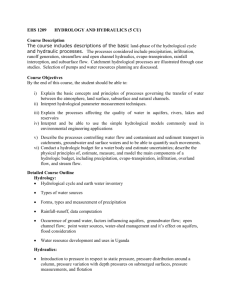
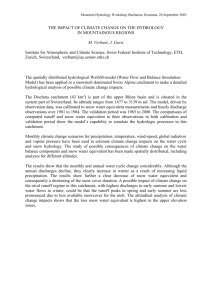
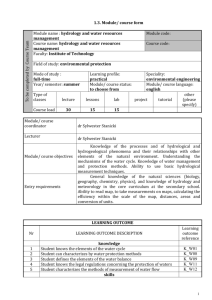

![Job description [DOC 33.50 KB]](http://s3.studylib.net/store/data/007278717_1-f5bcb99f9911acc3aaa12b5630c16859-300x300.png)

